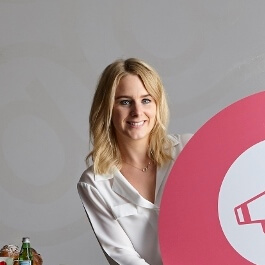For small businesses, influencer campaigns – using people to evangelise about your brand - feel out of reach financially. That’s why many are now starting to follow the trends set by ASOS, who rather than using influencers, is using its own people as brand advocates.
But where do you start if you don’t have a huge marketing team behind you? Here are my top tips for using employees as influencers as well as how to keep it affordable.
What is an influencer?
The term ‘influencer marketing’ has become more prevalent over the past couple of years and if your business has a social media strategy, you should also be considering how influencers can fit into the mix. But what is influencer marketing?
It now mainly refers to those who have a large and/or authoritative following on social media and use their influence to advocate other businesses’ products or services.
Although the term is relatively new, the concept isn’t. Take celebrity endorsements. For years celebrities have used their profile and credibility (and sometimes lost it) in order to promote brands, which pay them large sums to do so.
When we think about influencer marketing and how it came into the limelight, we immediately think of the Kardashians who have famously used their social media channels to tangibly commercialise their large followings.
A raft of reality TV stars have jumped on the bandwagon in order to subsidise, if not create an income.
However, paying thousands to get your brand talked about by a celeb won’t necessarily yield results. If people are aware that celebrities are only pushing certain brands or products because they are getting paid ridiculous amounts of money to do so, why should they trust them?
Micro-influencers
Micro-influencers are those people who have much smaller followings and a more direct and personal relationship with their audience. With this brings more trust and therefore many would argue a greater influence on a smaller scale.
Having a smaller audience means they are more likely to discuss and promote businesses and products they genuinely engage with because they make a positive difference to how they live their life day to day – not just the three weeks they are paid to promote it for.
The most valuable influencers for your brand don’t by any means need to have the biggest following or be famous. The most valuable ones need to be the best brand advocates.
That is to say, they are genuine fans of your business or products. With this in mind, why not take a leaf from ASOS’s book and turn to your own staff to act as your influencers?
Why use internal influencers?
Most of your employees will feel as though they are already advocates for your brand – they know the ins and outs of your company as well as all the USPs. They should know how to sell your company better than anyone.
Engaged workforces are more productive – no matter what position they hold within the company, any one of them could technically be an influencer. By giving them extra purpose and rewarding them, they will feel more ingrained in the company and therefore work harder towards a greater goal.
Some of your staff may already be promoting your services/products on social and chances are they could be influencers already, without being recognised or rewarded for it.
In order to establish who your influencers could be or how they can work for you, you’ll need to consider what you want to achieve first.
Do they need to tell your brand story in a more human and authentic way than you already do on your business’ social media accounts? Will they be able to create better understanding or make your company more accessible, perhaps by writing a more personal blog for the company website?
Getting it right
You do have to make sure you give employees the best chance to be successful as it can be daunting. So what do you need to equip your influencers with?
There are three things to will help grow confidence and success:
Training – how to use the communication channels you’ve selected and the best practice for using them. You could run a workshop or hire someone to come in and do this for you. It should cover how to get the best out of social platforms, how to convey the right tone, through to things like how and when to use hashtags.
Even people who are already au fait with social media should get training as things change all the time and it’s important to make sure everyone uses the channels in the same way.
Business updates – it’s so important to keep your influencers updated so they have something to talk about. Perhaps you’ve got a new menu or product range, or there’s been a big strategic move in the company such as an acquisition. Giving them content allows you to have better control over what they talk about and how they position your brand and get your message across.
Products to test or access to services – what better way to have your advocate promote your company by having first-hand experience of using whatever your company sells? We find that using an influencer to review your products delivers more value in the long-term than things like competition giveaways. There’s more of a human connection. Giving influencers products to try is also a great way to reward them for their efforts.
Finding the right people
There are several ways you can find influencers in your company:
Firstly, ask the question – who wants to be an influencer? Who in your organisation has the most suitable personality? Think about the extroverts!
Who is already acting like an influencer? Do any of your team have a large following or engagement on social? Do they already act like an influencer? Are they forever ‘hash-tagging’ and ‘selfie-ing’?
Is anyone in your team already seen as a ‘face of your brand’? Do they put themselves out there on behalf of your brand or are they visible on your website and social channels?
Internal faces and external faces
It’s not to say you should just work with internal micro-influencers. You may find there comes a time when you want to get other people involved. Here are some tips for finding external ones when the time is right:
Use your brand’s Instagram channel as a place to share your own brand’s images but also repost those of micro-influencers so you can start to engage with them.
Do hashtag research – the best are niche hashtags that you can follow more easily and can use to find micro influencers’ images and posts to share with your network.
Create a blog article with top Instagram accounts to follow and then contact the people that you include. This starts the relationship and you can build from here, interacting and reposting images your audience will like
As the relationship develops the potential to work together grows. For example, if you have a retail store then invite them down to try products and blog from your store. Otherwise send them a goodie bag!
If you’re unsure, then pick one micro-influencer and follow the tips above to start the relationship. Once you get going and see the benefit you can increase the number of people you work with.
By following a combination of these tips you can enjoy the benefits of an influencer marketing programme without the massive price tag. And of course, don’t forget there are plenty of experts who can support you to get the results you need.
Vicky Hockley is head of social media at Digirank.
Thanks for signing up to Minutehack alerts.
Brilliant editorials heading your way soon.
Okay, Thanks!


